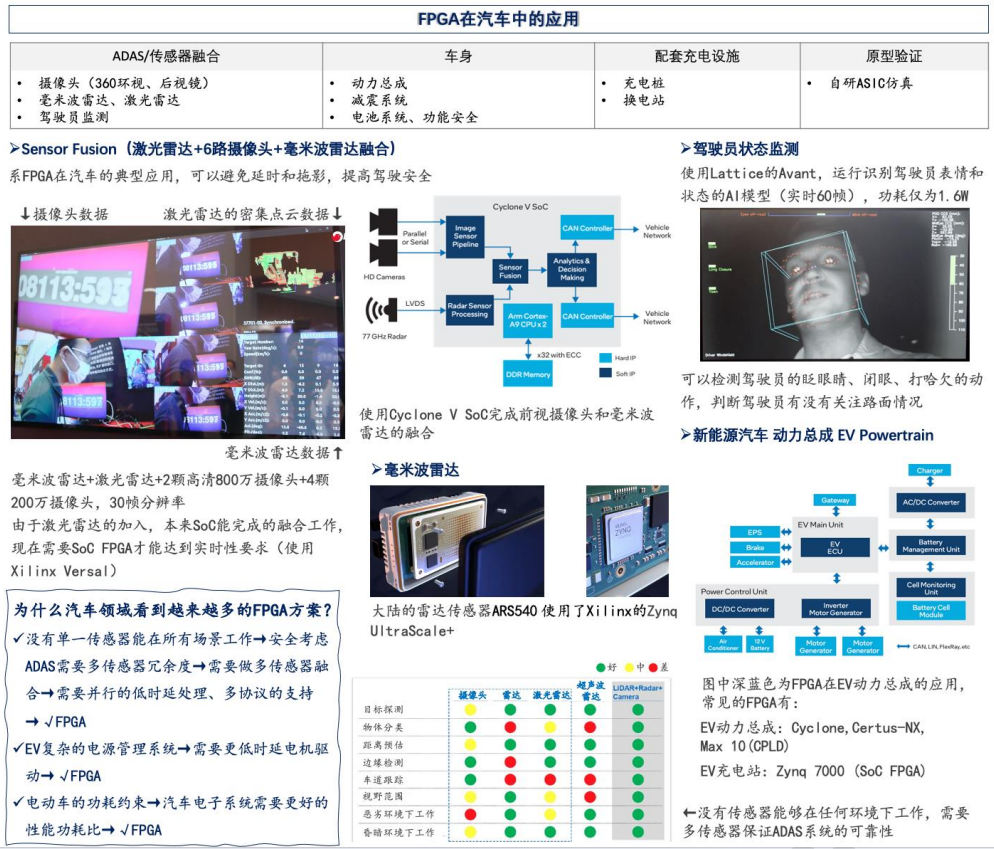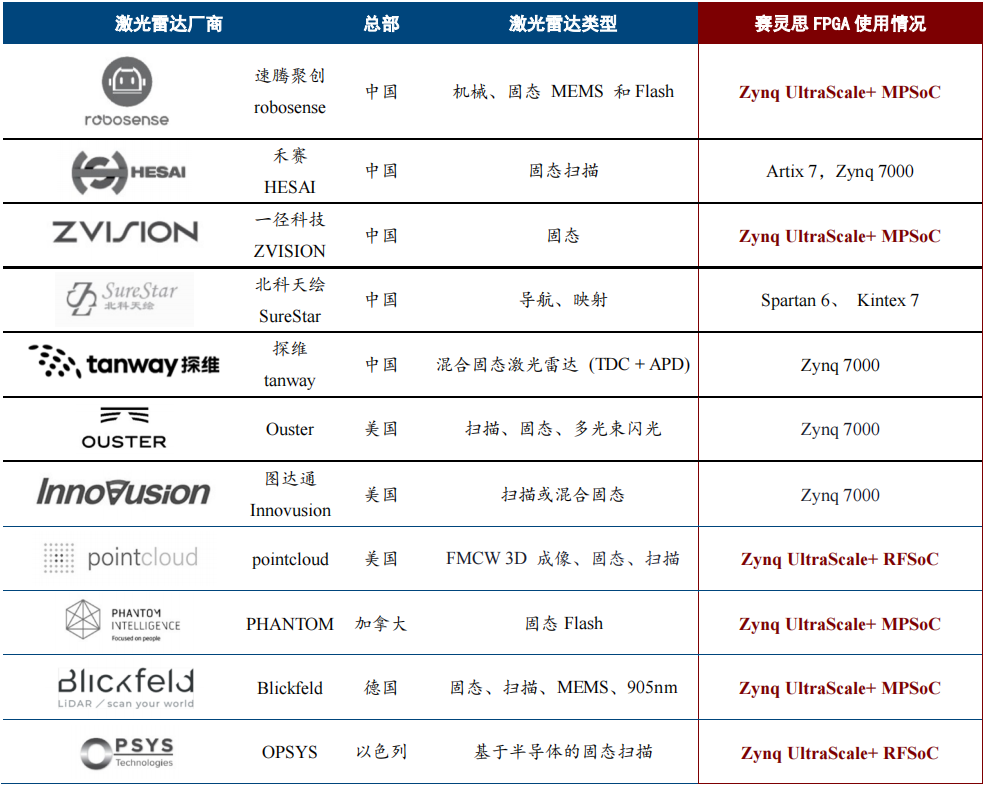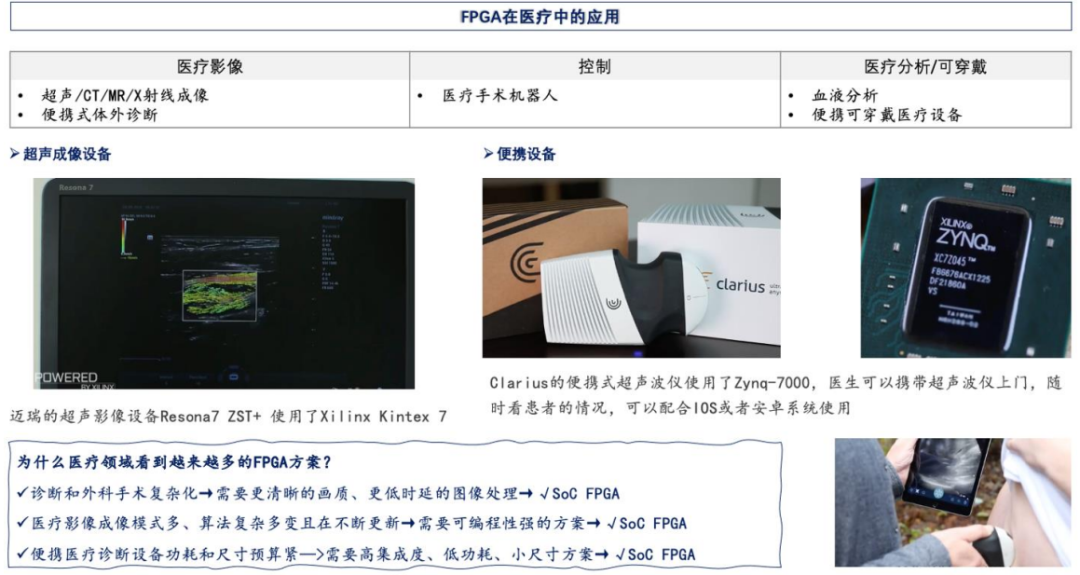
Click the “blue text” above to follow for more exciting content.
This article contains a total of 1079 words, and reading it will take approximately 3 minutes.
The downstream market for FPGA also includes automotive, multimedia & broadcasting, consumer electronics, and medical markets, each accounting for about 5%-10%. Among these fields, the automotive market is expected to grow rapidly in the coming years, potentially reaching a growth rate of 14%; the medical and consumer electronics sectors are expected to maintain a growth rate of around 11%.
Automotive Sector:
FPGA is primarily used in the automotive sector for ADAS and body control, with the demand for low-latency and highly flexible processing in vehicles continuously increasing the need for FPGAs. In ADAS scenarios, FPGAs are commonly applied in sensor fusion, such as the integration of multiple high-definition cameras and LiDAR sensors; in addition to sensor fusion, the high-speed signal processing of LiDAR itself is widely utilized in Xilinx’s SoC FPGA solutions, while driver state monitoring systems in the cabin also employ FPGA solutions. In the cabin domain, FPGAs are mainly responsible for bridging signals between SoCs and displays, as well as functions like image segmentation, frame rate adjustment, scaling, and rotation. Beyond ADAS systems, FPGAs are increasingly used in the powertrain systems of new energy vehicles, where their high parallelism enables better motor control.

FPGA is the mainstream processing solution for LiDAR manufacturers. LiDAR often involves extensive signal processing, requiring processors with strong parallel capabilities. Additionally, LiDAR algorithms are continuously iterating and upgrading, coupled with the constraints of automotive power consumption budgets, making FPGAs the best and indeed the most mainstream choice for LiDAR. Currently, major LiDAR manufacturers, including RoboSense, Hesai, and Ouster, have adopted Xilinx’s SoC FPGA Zynq series as the processors for their LiDAR products.
 Xilinx’s Zynq UltraScale MPSoC FPGA is widely used in multiple LiDAR systems.
Xilinx’s Zynq UltraScale MPSoC FPGA is widely used in multiple LiDAR systems.
In summary:
The main application scenarios and reasons for FPGA in the automotive sector are as follows:
Low-latency processing capabilities (ADAS, control);
Highly flexible programmability (EV power systems);
Additionally, the growth drivers include:
No single sensor can work in all scenarios → Safety considerations require multi-sensor redundancy in ADAS → Multi-sensor fusion is needed → Requires parallel low-latency processing and support for multiple protocols → Increased FPGA penetration and value;
Complex power management systems in EVs → Need for lower latency motor drives → Increased FPGA penetration and value;
Power consumption constraints in electric vehicles → Automotive electronic systems require better performance-to-power ratios → Increased FPGA penetration and value.
Medical Sector:
The high-definition imaging in medical imaging is the growth driver for FPGA in the medical field. FPGAs are commonly used for real-time processing of medical images, such as real-time high-definition imaging in ultrasound, CT, and MRI devices. Due to the complex and ever-changing algorithms in the medical field, FPGA solutions can help industry clients iterate quickly. Furthermore, in portable medical imaging devices, SoC FPGAs can provide high integration, low power consumption, and small size solutions.

In summary:
The main application scenarios and reasons for FPGA in the medical field are as follows:
High parallel low-latency processing (medical imaging, medical robotics);
High flexibility, high parallelism, and low power solutions (portable medical devices).
Additionally, the growth drivers include:
Complexity in medical diagnostics and surgeries → Need for higher image quality and lower latency image processing → Increased FPGA value;
Diverse imaging modes and complex, ever-changing algorithms in medical imaging → Need for highly programmable solutions → Increased FPGA value;
Power and size constraints in portable medical diagnostic devices → Need for high integration, low power, and small size solutions → Increased FPGA value.

Risk Warning:This content only represents the analysis, speculation, and judgment of the Breaking Research team, and is published here solely for the purpose of conveying information, not as a basis for specific investment targets. Investment carries risks; please proceed with caution!Copyright Statement:This content is copyrighted by the original party or author. If reproduced, please indicate the source and author, retain the original title, and ensure the integrity of the article content, and bear legal responsibilities for copyright, etc.
END
